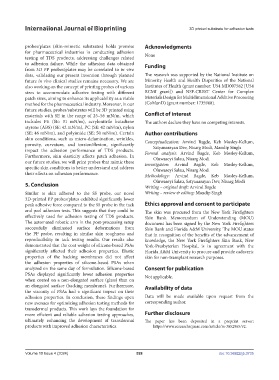Page 536 - IJB-10-4
P. 536
International Journal of Bioprinting 3D printed substrate for adhesion tests
probes/plates (skin-mimetic substrates) holds promise Acknowledgments
for pharmaceutical industries in conducting adhesion None
testing of TDS products, addressing challenges related
to adhesion failure. While the adhesion data obtained Funding
from 3D PP probes/plates may be correlated to in vivo
data, validating our present invention through planned The research was supported by the National Institute on
future in vivo clinical studies remains necessary. We are Minority Health and Health Disparities of the National
also working on the concept of printing probes of various Institutes of Health (grant number: U54 MD007582 [U54
sizes to accommodate adhesive testing with different RCMI grant]) and NSF-CREST Center for Complex
patch sizes, aiming to enhance its applicability as a viable Materials Design for Multidimensional Additive Processing
method for the pharmaceutical industry. Moreover, in our (CoManD) (grant number: 1735968).
future studies, probes/substrates will be 3D printed using
materials with SE in the range of 25–56 mN/m, which Conflict of interest
includes PE (SE: 31 mN/m), acrylonitrile butadiene The authors declare they have no competing interests.
styrene (ABS) (SE: 42 mN/m), PC (SE: 42 mN/m), nylon
(SE: 46 mN/m), and polyimide (SE: 50 mN/m). Certain Author contributions
skin conditions, such as micro-delamination, wrinkles,
porosity, curvature, and torsion/flexion, significantly Conceptualization: Arvind Bagde, Keb Mosley-Kellum,
Satyanarayan Dev, Nisarg Modi, Mandip Singh
impact the adhesion performance of TDS products. Formal analysis: Arvind Bagde, Keb Mosley-Kellum,
Furthermore, skin elasticity affects patch adhesion. In Oluwaseyi Salau, Nisarg Modi
our future studies, we will print probes that mimic these Investigation: Arvind Bagde, Keb Mosley-Kellum,
specific skin conditions to better understand and address Oluwaseyi Salau, Nisarg Modi
their effects on adhesion performance. Methodology: Arvind Bagde, Keb Mosley-Kellum,
Oluwaseyi Salau, Satyanarayan Dev, Nisarg Modi
5. Conclusion Writing – original draft: Arvind Bagde
Similar to skin adhered to the SS probe, our novel Writing – review & editing: Mandip Singh
3D-printed PP probes/plates exhibited significantly lower
peak adhesive force compared to the SS probe in the tack Ethics approval and consent to participate
and peel adhesion tests. This suggests that they could be The skin was procured from the New York Firefighters
effectively used for adhesion testing of TDS products. Skin Bank. Memorandum of Understanding (MOU)
The automated robotic arm in the post-processing setup document has been signed by the New York Firefighters
successfully eliminated surface deformations from Skin Bank and Florida A&M University. The MOU states
the PP probe, resulting in similar skin roughness and that in recognition of the benefits of the advancement of
reproducibility in tack testing results. Our results also knowledge, the New York Firefighters Skin Bank, New
demonstrated that the coat weight of silicone-based PSAs York-Presbyterian Hospital, is in agreement with the
significantly affected their adhesion properties. Elastic Florida A&M University to procure and provide cadaveric
properties of the backing membranes did not affect skin for non-transplant research purposes.
the adhesion properties of silicone-based PSAs when
analyzed on the same day of formulation. Silicone-based Consent for publication
PSAs displayed significantly lower adhesion properties Not applicable.
when coated on a non-elongated surface (glass) than on
an elongated surface (backing membrane). Furthermore, Availability of data
the viscosity of PSAs had a significant impact on their
adhesion properties. In conclusion, these findings open Data will be made available upon request from the
new avenues for optimizing adhesion testing methods for corresponding author.
transdermal products. This work lays the foundation for
more efficient and reliable adhesion testing approaches, Further disclosure
ultimately enhancing the development of transdermal The paper has been deposited in a preprint server:
products with improved adhesion characteristics. https://www.researchsquare.com/article/rs-3852965/v2.
Volume 10 Issue 4 (2024) 528 doi: 10.36922/ijb.3735

